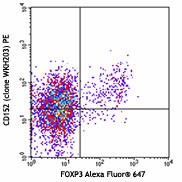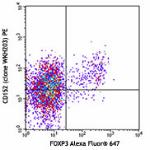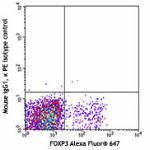- Clone
- WKH203 (See other available formats)
- Regulatory Status
- RUO
- Other Names
- Cytotoxic T Lymphocyte-Associated Antigen-4 (CTLA-4), Ly-56
- Isotype
- Mouse IgG1, κ
- Ave. Rating
- Submit a Review
- Product Citations
- publications

-

LOU rat lymph node cells were stimulated with plate-bound CD3 and CD28 for 3 days, then surface stained with CD4 PerCP. This was followed by fixation and permeabilization with BioLegend's FOXP3 Fix/Perm Buffer Set and intracellular staining with FOXP3 Alexa Fluor® 647, and CD152 (clone WKH203) PE (top) or mouse IgG1, κ PE isotype control (bottom). The data was analyzed by gating on CD4-positive cells. -

| Cat # | Size | Price | Quantity Check Availability | Save | ||
|---|---|---|---|---|---|---|
| 203007 | 25 µg | £81 | ||||
CD152 is a 33 kD member of the immunoglobulin superfamily also known as CTLA-4 or Ly-56. It is expressed on activated T and B lymphocytes. CD152 is similar to CD28 in amino acid sequence, structure, and genomic organization and these two receptors share common B7 family counter-receptors (B7-1, B7-2). Whereas CD28 delivers a costimulatory signal in T cell activation, CTLA-4 negatively regulates cell-mediated immune responses. CD152 is thought to play a role in the induction and maintenance of immunological tolerance, as well as the development of protective immunity and thymocyte regulation.
Product DetailsProduct Details
- Verified Reactivity
- Rat
- Antibody Type
- Monoclonal
- Host Species
- Mouse
- Formulation
- Phosphate-buffered solution, pH 7.2, containing 0.09% sodium azide.
- Preparation
- The antibody was purified by affinity chromatography, and conjugated with PE under optimal conditions.
- Concentration
- 0.2 mg/ml
- Storage & Handling
- The antibody solution should be stored undiluted between 2°C and 8°C, and protected from prolonged exposure to light. Do not freeze.
- Application
-
ICFC - Quality tested
- Recommended Usage
-
Each lot of this antibody is quality control tested by intracellular immunofluorescent staining with flow cytometric analysis. For flow cytometric staining, the suggested use of this reagent is ≤1.0 µg per million cells in 100 µL volume. It is recommended that the reagent be titrated for optimal performance for each application.
- Excitation Laser
-
Blue Laser (488 nm)
Green Laser (532 nm)/Yellow-Green Laser (561 nm)
- Application Notes
-
Additional reported applications (for the relevant formats) include: immunoprecipitation1.
-
Application References
(PubMed link indicates BioLegend citation) -
- Lin CH and Hunig T, et al. 2003. Eur. J. Immunol. 33:626. (IP)
- Nessi V, et al. 2010. J. Immunol. 185:5656. PubMed
- RRID
-
AB_2276898 (BioLegend Cat. No. 203007)
Antigen Details
- Structure
- Ig superfamily, 33 kD
- Distribution
-
Activated T and B cells
- Function
- Negative regulator of T cell activation
- Ligand/Receptor
- CD80 (B7-1), CD86 (B7-2)
- Cell Type
- B cells, T cells
- Biology Area
- Immunology
- Molecular Family
- CD Molecules, Immune Checkpoint Receptors
- Antigen References
-
1. Barclay A, et al. 1997. The Leukocyte Antigen FactsBook Academic Press.
2. Allison JP, et al. 1995. Science 270:932.
3. Waterhouse P, et al. 1995. Science 270:985.
4. Linsley PS, et al. 1991. J. Exp. Med. 174:561. - Gene ID
- 63835 View all products for this Gene ID
- UniProt
- View information about CD152 on UniProt.org
Related FAQs
- What type of PE do you use in your conjugates?
- We use R-PE in our conjugates.
Other Formats
View All CD152 Reagents Request Custom Conjugation| Description | Clone | Applications |
|---|---|---|
| PE anti-rat CD152 | WKH203 | ICFC |
Compare Data Across All Formats
This data display is provided for general comparisons between formats.
Your actual data may vary due to variations in samples, target cells, instruments and their settings, staining conditions, and other factors.
If you need assistance with selecting the best format contact our expert technical support team.
-
PE anti-rat CD152

LOU rat lymph node cells were stimulated with plate-bound CD... 

 Login / Register
Login / Register 













Follow Us